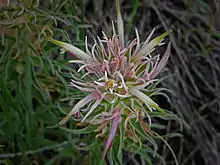Castilleja sessiliflora
Castilleja sessiliflora is a species of flowering plant in the family Orobanchaceae known by the common names downy Indian paintbrush and downy paintedcup. It is native to the Great Plains of North America from southern Canada, through the central United States, to northern Mexico. It occurs as far west as the eastern slopes of the Rocky Mountains.[1]
| Castilleja sessiliflora | |
|---|---|
 | |
| Scientific classification | |
| Kingdom: | Plantae |
| Clade: | Tracheophytes |
| Clade: | Angiosperms |
| Clade: | Eudicots |
| Clade: | Asterids |
| Order: | Lamiales |
| Family: | Orobanchaceae |
| Genus: | Castilleja |
| Species: | C. sessiliflora |
| Binomial name | |
| Castilleja sessiliflora | |
Description
This perennial herb produces one or more stems up to 35 centimetres (14 in) tall from a woody root crown. It is hemiparasitic, obtaining water and nutrients from other plants by tapping their roots. This Castilleja species has been observed parasitizing eastern redcedar (Juniperus virginiana) and oldfield juniper (J. communis var. depressa). It reproduces sexually and vegetatively by resprouting from its root crown.[1]
The petals are fused and form a curvilinear tube.[2] The sepals are shorter, with narrow lobes.[2] Altogether, the inflorescence is green, yellowish, and pink.[2]
This plant grows in several habitat types, including prairie, shinnery, Texas savanna, and shrubsteppe.[1] It is pollinated by a hawk moth.[2]
References
- Walsh, Roberta A. (1993). "Castilleja sessiliflora". Fire Effects Information System (FEIS). US Department of Agriculture (USDA), Forest Service (USFS), Rocky Mountain Research Station, Fire Sciences Laboratory.
- Taylor, Ronald J. (1994) [1992]. Sagebrush Country: A Wildflower Sanctuary (rev. ed.). Missoula, MT: Mountain Press Pub. Co. p. 60. ISBN 0-87842-280-3. OCLC 25708726.
External links
- Castilleja sessiliflora in the CalPhotos photo database, University of California, Berkeley
